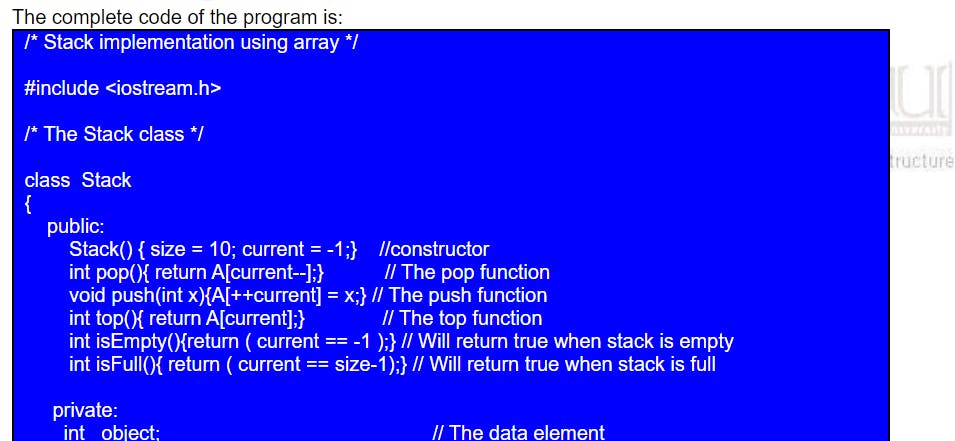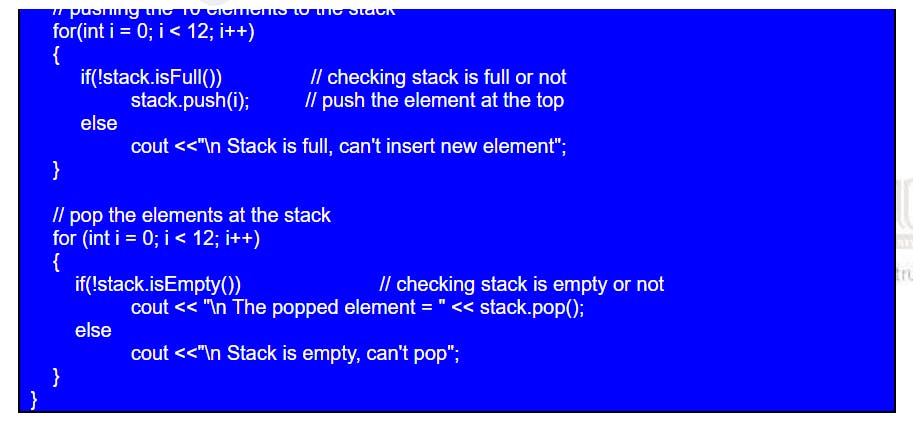Notes- ADT and Stack
Abstract Data type and Stack explained with code samples
The use of a circular linked list simplifies the solution by providing a straightforward implementation. By utilizing the methods of the CList class, the code becomes concise and easy to understand. In contrast, using an array to solve the problem would result in complex code with intricate navigation and element removal logic. Additionally, the circular list class can be reused in other programs, enhancing code reusability.
PermalinkAbstract Data Type
An abstract data type (ADT) defines a data type based on a mathematical concept and the operations performed on that data type. A list data structure can be implemented in various ways (array, singly linked list, doubly linked list, circular linked list). The implementation can be changed without affecting the interface. ADTs allow focusing on functionality, not implementation details.
ADTs provide methods like add, get, and remove for list operations. Users are independent of the internal implementation. C++ classes enable creating ADTs with benefits such as encapsulation. Performance should be considered, and internal implementations can be changed without affecting users.
PermalinkStacks & Methods for Stack
A stack is a data structure where elements are arranged in a linear order. It follows the principle of adding and removing items from the top. In real-life examples like stacks of books or plates, we can only access the topmost item. The last item added is the first to be removed. It is important to handle stacks carefully to prevent items from falling.
A stack is a data structure where elements are added and removed only from the top. The interface methods for stacks include:
push(x): Insert an element x at the top of the stack.
pop(): Remove and return the top element of the stack.
top(): Return the top element without removing it.
The push operation adds an element to the top of the stack, pop removes the top element, and top retrieves the top element without removing it. A stack can be visualized as plates stacked in a cylinder in a kitchen, where taking a plate pops the other plates up.
PermalinkStack Data Structure and LIFO Principle
A stack follows the Last In First Out (LIFO) principle, where the last element pushed into the stack is the first one to be removed. We use the push() method to add elements to the top of the stack, and the pop() method to remove and return the top element. The stack can be checked if it's empty using the isEmpty() function, which returns true if there are no elements in the stack.
When popping from an empty stack, we can either use an isEmpty() check before calling pop(), or we can handle it with exceptions in advanced programming languages. Exceptions are used to handle unexpected or erroneous conditions, but for now, we will stick to the isEmpty() method to ensure the stack is not empty before popping an element.
PermalinkStack Implementation with Arrays - Best Case Scenario
When implementing a stack using arrays, it is best to insert and remove elements at the end of the array to avoid shifting elements. Pushing elements at the end requires no shifting, and popping the last element also eliminates the need for shifting. This approach ensures efficient stack operations without unnecessary overhead.
PermalinkUse of isFull() method and isEmpty(()
When implementing a stack using an array, the most recent element is stored at the end of the array, following the Last-In-First-Out (LIFO) principle. To avoid potential overflow issues, the stack provides an isFull() method to check if the array is full before pushing elements. Additionally, the interface includes isEmpty() and isFull() methods to determine if the stack is empty or full, respectively.
PermalinkImplementation of stack



Output:

#include <iostream>
using namespace std;
class stack
{
public:
stack()
{
size = 10;
current = -1;
}
int pop()
{
return A[current--];
}
void push(int x)
{
A[++current] = x;
}
int top(){return A[current];}
int isEmpty(){return (current==-1);}
int isFull(){return (current ==size-1);}
private:
int object;
int current;
int size;
int A[10];
};
int main()
{
stack stack;
for(int i=0;i<12;i++)
{
if(!stack.isFull())
stack.push(i);
else
cout<<"\n stack is full,can't insert new element";
}
for(int i=0;i<12;i++)
{
if(!stack.isEmpty())
cout<<"\n the popped element ="<<stack.pop();
else
cout <<"\n stack is empty ,can't pop";
}
}
PermalinkNotes
PermalinkPop Function:
current--subtracts 1 from the value ofcurrentafter its current value is used. This means that the current value is used in the expression and then decreased by 1.A[current--]accesses the arrayAat the current index value ofcurrentand retrieves the element stored at that position.return A[current--];returns the element obtained fromA[current--]as a result of thepopoperation.
PermalinkPush Function:
++currentincrement the valuecurrentby 1 before its current value is used. This means thatcurrentis increased by 1 and then used in the expression.A[++current]accesses the arrayAat the updated index value ofcurrent. It effectively represents the next available position in the array to insert the elementx.A[++current] = x;assigns the valuexto the position in the array indicated by++current. This line stores the elementxat the top of the stack, effectively pushing it onto the stack.
PermalinkOther Functions:
top()allows the user to access the top element without modifying the stack.isEmpty()helps determine if the stack is empty before performing operations likepop.isFull()helps determine if the stack is full before performing operations likepush.
PermalinkInt Main Explained
The main() function creates a stack object and performs two loops.
In the first loop, it pushes values 0 to 11 into the stack using stack.push(i), checking if the stack is not full. If the stack becomes full, it displays "stack is full, can't insert new element".
In the second loop, it pops and prints elements from the stack using stack.pop(), checking if the stack is not empty. If the stack is empty, it displays "stack is empty, can't pop".
This code initializes a stack, pushes elements into it, and then pops and prints the elements from the stack. It handles cases when the stack is full or empty.
PermalinkConclusion:
In this blog, we explored the concept of stack data structures and their importance in computer science and programming. We discussed the Last-In-First-Out (LIFO) principle that governs stack operations, where elements are added and removed from the top of the stack.
We examined two different implementations of stacks: using a circular linked list and an array. While both approaches have their merits, the use of a circular linked list simplifies the implementation by providing a straightforward and efficient solution. The CList class, with its methods like add, get, and remove, offers a concise and easy-to-understand implementation of the stack data structure.
Compared to an array-based implementation, which involves intricate navigation and element removal logic, the circular linked list approach stands out with its simplicity and code reusability. The circular list class can be easily adapted and reused in other programs, enhancing code reusability and maintainability.
It is important to consider performance when implementing stack data structures. By leveraging the benefits of a circular linked list, we can achieve efficient stack operations without unnecessary overhead. The time and space complexity of the operations are optimized, ensuring fast and reliable stack functionality.
In conclusion, understanding and implementing stack data structures using a circular linked list can greatly benefit programmers and software developers. By grasping the principles of stacks, choosing the appropriate implementation, and considering performance aspects, you can efficiently manage and manipulate data in a stack-like fashion, opening doors to a wide range of applications in programming.
Remember, practice and experimentation are key to mastering stack implementation and utilizing them effectively in your programs. Happy coding!
By adding a conclusion, you provide a sense of closure to your blog and reinforce the main points you discussed throughout the article.
Subscribe to our newsletter
Read articles from Laiba's Blog directly inside your inbox. Subscribe to the newsletter, and don't miss out.

Article Series
Array Of Objects
An array of objects is and could be constructed exactly like how we create an array of int or other …
Operator Overloading
OVERLOADING Overloading means that users can define pre-defined stuff again according to them and ma…
Notes- ADT and Stack
The use of a circular linked list simplifies the solution by providing a straightforward implementat…
Notes - Stack with Linked List
Intro In this blog, we will explore the implementation of a stack using a linked list and discuss th…
Evaluating a Postfix Expression Using a Stack -Code C++
Code #include <iostream> #include <stack> #include <cmath> // For exponentiation operator (^) using…